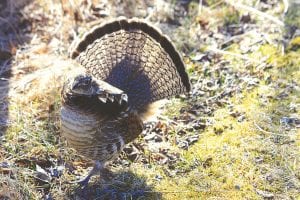Minnesota’s ruffed grouse spring drumming counts were lower than last year across most of the bird’s range, according to a survey conducted by the Minnesota Department of Natural Resources (DNR).
Compared with drumming counts conducted in 2011, 2012 survey results showed an average decline of 24 to 60 percent, to 1.1 drums per stop, in the northeast survey region, which is the core and bulk of grouse range in Minnesota. Drumming counts in the northwest declined 33 to 73 percent to 0.9 drums per stop. Drumming counts did not change significantly in the central hardwoods or southeast, which had averages of 0.6 and 0.7 drums per stop, respectively.
“The grouse population is in the declining phase of its 10-year cycle,” said Mike Larson, DNR wildlife research group leader and grouse biologist. “The most recent peak in drum counts was during 2009, but hunter harvests remained relatively high through at least 2010.”
Ruffed grouse populations, which tend to rise and fall on a 10-year cycle, are surveyed by counting the number of male ruffed grouse heard drumming on established routes throughout the state’s forested regions. This year observers recorded 1.0 drums per stop statewide. The averages during 2010 and 2011 were 1.5 and 1.7 drums per stop, respectively. Counts vary from about 0.8 drums per stop during years of low grouse abundance to about 1.9 during years of high abundance.
Drumming counts are an indicator of the ruffed grouse breeding population. The number of birds present during the fall hunting season also depends upon nesting success and chick survival during the spring and summer. Minnesota frequently is the nation’s top ruffed grouse producer. On average, 115,000 hunters harvest 545,000 ruffed grouse in Minnesota each year, also making it the state’s most popular game bird.
For the past 63 years, DNR biologists have monitored ruffed grouse populations. This year, DNR staff and cooperators from 15 organizations surveyed 126 routes across the state.



Loading Comments